# Rulebook
# Components
# Phoenixborn Card
Your Phoenixborn is your most important card. Its battlefield and spellboard values dictate how many units and ready spells you can have in play at a time and its life value is how many wound tokens can be placed on it before you are out of the game. A Phoenixborn is not a unit.[1][2]

References
1. Ashes Reborn Rulebook v1.5, p3
2. Red Rains Rulebook p2
# Unit Cards
Allies and conjurations are the two types of units that you will summon to your battlefield. Units on your battlefield are under your control.[1][2]
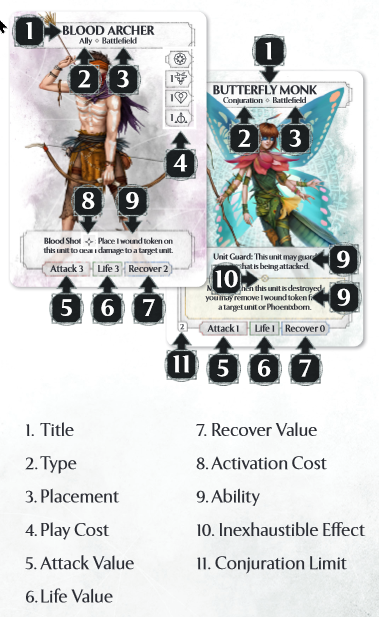
Ally (Unit)
Allies are a type of unit. Iron Worker is an ally [1] which will be played to your battlefield [2]. To play the Iron Worker, pay its costs [3], and then place the Iron Worker in an empty slot on your battlefield. The number of battlefield slots is determined by the battlefield value on your Phoenixborn.
- Attack value: how much damage a unit deals in battle.
- Life value: how many wound tokens it takes to destroy a unit.
- Recover value: how many wound tokens are removed from a unit during the recovery phase.
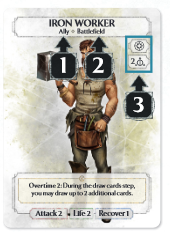
Conjuration (Unit)
Conjurations are a type of unit. Conjurations start in a conjuration pile, are brought into play by other card effects, and return to that conjuration pile when they leave play. Their attack, life and recover values work exactly the same as an ally’s.
References
1. Ashes Reborn Rulebook v1.5, p3
2. Red Rains Rulebook p2
# Spell Cards
Action and reaction spells are discarded for one-time effects whereas ready and alteration spells have longer lasting effects. The spells in your play area are under your control.[1][2]
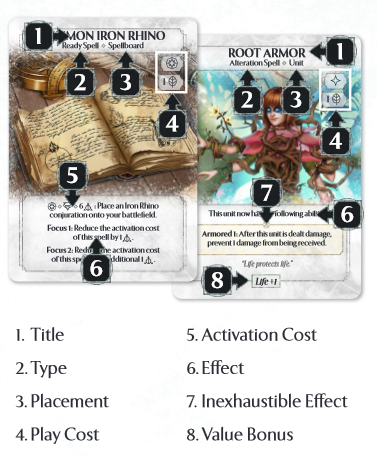
Action Spell
Action spells have a one-time effect. Seal is an action spell [1] which will be played to your discard pile [2]. To play Seal, pay its play cost [3], carry out its effect, and then discard it.
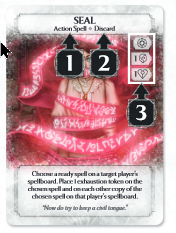
Alteration Spell
Alteration spells modify the units they are attached to. Root Armor is an alteration spell [1] which can be played (attached) to any unit in play [2] on either battlefield. To play Root Armor, pay its costs [3], and then target any unit in play and attach the spell by placing it underneath that unit. As long as Root Armor remains attached to the unit, its card text and value bonuses modify the unit. In this case, the unit gains the ability Armored 1 [4] and its life value is increased by 1 [5].
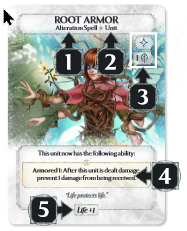
Conjured Alteration Spell
Conjured alteration spells are considered to be alteration spells, not conjurations, while in play. Conjured alteration spells start in a conjuration pile, are brought into play by other card effects, and return to that conjuration pile when they leave play.
Ready Spell
Ready spells usually do not have an immediate effect, but will remain in play to be activated later. Summon Silver Snake is a ready spell [1] which will be played to your spellboard [2]. To play Summon Silver Snake, pay its play cost [3], and then place Summon Silver Snake in an empty slot on your spellboard. The number of spellboard slots is determined by the spellboard value on your Phoenixborn.
If you already have 1 or more copies of the same ready spell on your spellboard, place the new one on top of the existing one(s)—it does not take up an extra slot.
On a subsequent turn you can activate Summon Silver Snake by paying its activation cost [4], taking a Silver Snake conjuration from your conjuration pile and placing it in an empty slot on your battlefield.

Focusing a Ready Spell
If you have placed 2 or 3 copies of a ready spell on top of each other, that spell is focused. Each copy of a ready spell is separate, can have its own exhaustion and status tokens, and can be activated separately, paying all activation costs each time.
Some ready spells have effects that say Focus 1 or Focus 2. A spell’s Focus 1 effect becomes active for all copies of that spell when it has been focused at least once (1 additional copy on your spellboard). A spell’s Focus 2 effect becomes active when the spell has been focused at least twice (2 additional copies on your spellboard).
Reaction Spell
Reaction spells can be played on any player’s turn, when its conditions are met. Reactions can only be played during a player’s turn, and each playercan only play one reaction per turn. Shadow Strike is a reaction spell [1] which will be played to your discard pile [2]. You have Shadow Strike in your hand when your opponent declares attackers. You respond by playing Shadow Strike, paying its play cost [3], carrying out its effects, and then discarding it.
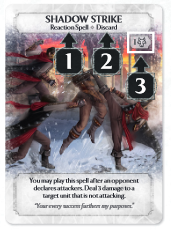
Other Reactions
Some cards have reaction abilities or effects on them, indicated by a blue box. These cards may be played from your hand as reactions when their conditions are met. Using a reaction ability or effect counts toward your limit of 1 reaction per turn.
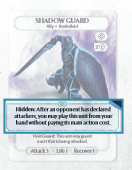
References
1. Ashes Reborn Rulebook v1.5, p4
2. Red Rains Rulebook p3
# Chimera Cards
#### Chimera
The Chimera is a shared opponent of the players and can be standard or heroic difficulty. Within that difficulty they range from levels 1 to 3, which are played against consecutively in a campaign. Standard difficulty Chimera are a good place to start, especially if you are new to Ashes. Heroic difficulty Chimera will test the skills of even the most veteran players! The Chimera must receive wound tokens equal to or greater than its life value for you to win the game.
[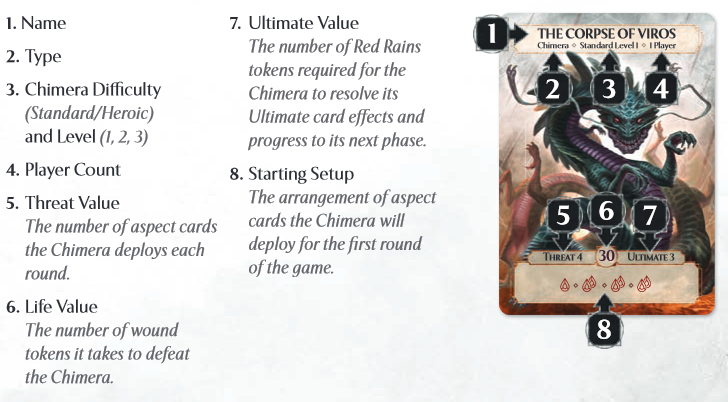](https://wiki.ashes.live/uploads/images/gallery/2023-09/8fZimage.png)
#### Aspect
Aspect cards represent different aspects of the Chimera that it will deploy to its battlefield throughout the course of its battle against you. Aspects are a type of unit and are considered to be all other types of unit (like ally or conjuration).
[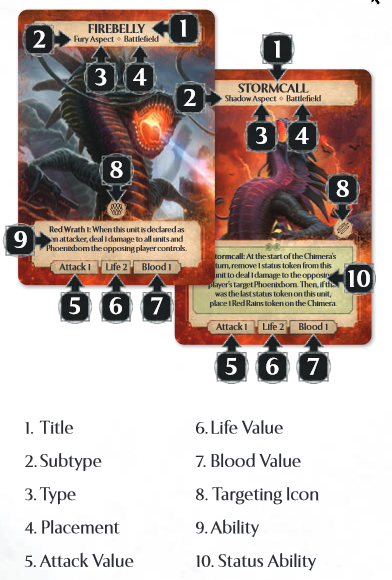](https://wiki.ashes.live/uploads/images/gallery/2023-09/a0kimage.png)[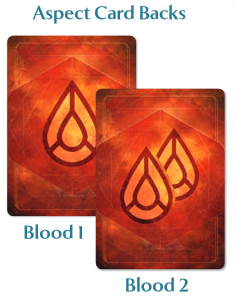](https://wiki.ashes.live/uploads/images/gallery/2023-09/ZfLimage.png)
#### Note on Type:
While playing the game, aspects are considered to be allies, conjurations, and units, and the Chimera is considered to be a player, opponent, and its own Phoenixborn.
#### Behavior
Behavior cards, along with the behavior die, dictate the Chimera’s actions.
[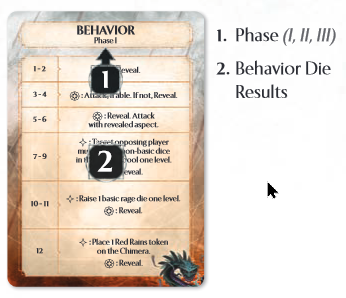](https://wiki.ashes.live/uploads/images/gallery/2023-09/bUXimage.png)
#### Ultimate
Ultimate cards list the effects that will resolve after the Chimera collects Red Rains tokens equal to its Ultimate value.
[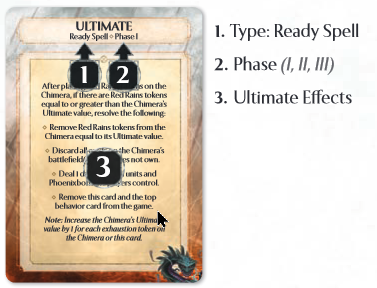](https://wiki.ashes.live/uploads/images/gallery/2023-09/SQOimage.png)
#### Fatigued
This card is placed under the Chimera’s draw pile during setup. When the Chimera empties its draw pile (or when it empties it twice in a 2 player game), it becomes fatigued. Follow the card’s instructions.
[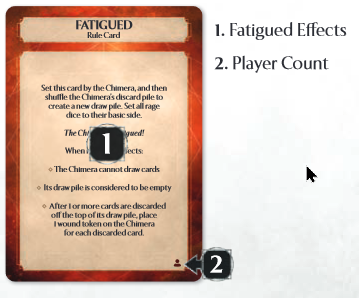](https://wiki.ashes.live/uploads/images/gallery/2023-09/JBgimage.png)
# Dice
Dice are the magic that let you cast spells and summon units. You will encounter many ypes of dice in your battles; four types come in the master set.
Each die has three levels: power > class > basic. Higher level dice can be used to pay for lower level costs.
- A power symbol can be used as that die’s power, class or basic symbol.
- A class symbol can be used as that die’s class or basic symbol.
In addition, each die’s power symbol can be spent to activate a dice power effect.\[[1](https://wiki.ashes.live/books/rulebook/page/dice/#1)\]
[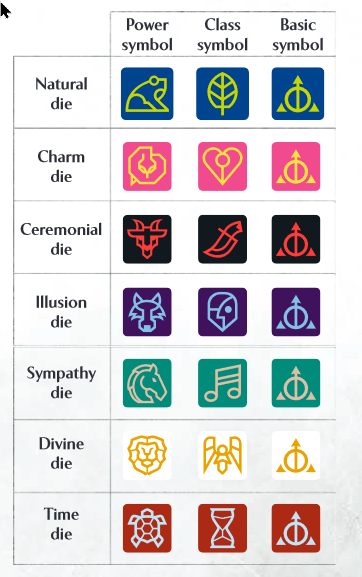](https://wiki.ashes.live/uploads/images/gallery/2023-05/Y4vimage.png)
### Red Rains
#### Behavior Die
The behavior die, along with the behavior cards, dictate the Chimera’s actions.
[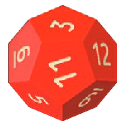](https://wiki.ashes.live/uploads/images/gallery/2023-09/GvRimage.png)
#### Rage Dice
The Chimera has 5 rage dice that power up over time to generate Red Rains tokens that will eventually trigger its Ultimate effect! Each rage die has 3 power sides and 3 basic sides.
[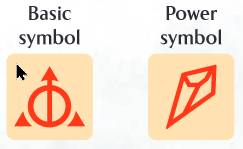](https://wiki.ashes.live/uploads/images/gallery/2023-09/RFgimage.png)
References
[1.](#1) [Ashes Reborn Rulebook](https://wiki.ashes.live/books/rulebook/page/pdfs-pvp) v1.5, p4
# Tokens
[](https://wiki.ashes.live/uploads/images/gallery/2023-05/x3zimage.png)
### Red Rains
In Ashes: Red Rains there is an additional token type called "Red Rains" which are used to trigger the Chimera's Ultimate effect.
[](https://wiki.ashes.live/uploads/images/gallery/2023-09/KE9image.png)
References
[1.](#1) [Ashes Reborn Rulebook](https://wiki.ashes.live/books/rulebook/page/pdfs-pvp) v1.5, p4
# Chimera Board
[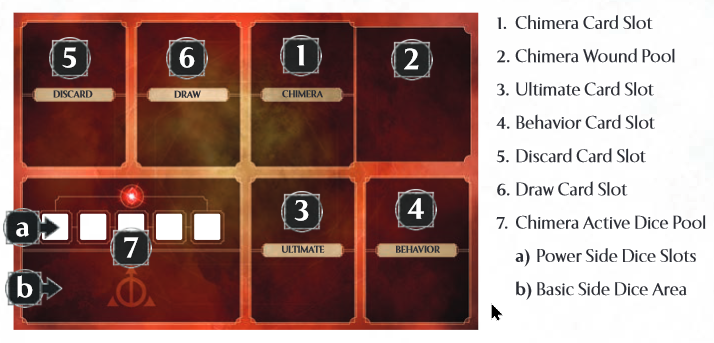](https://wiki.ashes.live/uploads/images/gallery/2023-09/cXiimage.png)
# Game Setup
To set up a game of Ashes, each player should do the following:
1. Choose a deck to play with (see pp. 18-19 for suggested decks). Or build a deck to play with (see p. 18 for deck building rules). Or draft a deck to play with (see pp. 20-21 for drafting rules).
2. Place your Phoenixborn in your play area with the information side face up.
3. Place your conjuration pile face down in your play area.
4. Place the dice power reference cards that correspond to the dice you are using in your play area and take a phases of play reference card, if needed.
5. Place all ten of your dice to the right of your dice power reference cards. This is your exhausted dice pool.
6. Choose your First Five by taking five different cards of your choice from your deck. This is your starting hand. You cannot include more than one copy of a card in your First Five. Shuffle the rest of your deck and form a face down draw pile in
your play area.
7. Make sure you have easy access to wound, exhaustion and status tokens.
Note: Your play area does not need to be organized like the example, but the different sections must be easily recognizable by your opponent.
[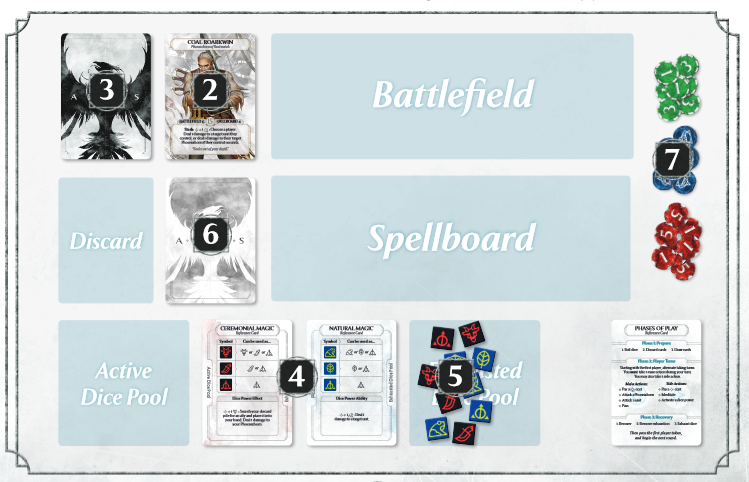](https://wiki.ashes.live/uploads/images/gallery/2023-05/N8eimage.png)
## Red Rains Setup
First, choose whether to play a 3 game campaign or a standalone game (see Red Rains Campaign on page 17). The campaign is the recommended experience, but players may also use any deck against the Chimera of their choice in a standalone game.[2](https://wiki.ashes.live/books/rulebook/page/game-setup#bkmrk-ref-2)
1. Decide what difficulty level you will play at and place the corresponding Chimera card, single player side up, on its designated space on the Chimera board.
2. Create stacks of the behavior and Ultimate cards, with the phase I cards on top, followed by the phase II and phase III cards beneath them.
3. Place the behavior die near the behavior cards.
4. Set all 5 rage dice to their basic side and place them in the Chimera’s active dice pool.
5. Gather 18 aspects that all share the same subtype. In this set you will have a choice between gathering all 18 Fury aspects or all 18 Shadow aspects.
- ***Recommended******:*** Choose all aspects of the same subtype (Fury or Shadow are included in the Corpse of Viros expansion).
- ***Custom Chimera:*** Choose any 9 Blood 1 and 9 Blood 2 aspects that you desire.
- ***Random Chimera**:* Shuffle a stack of Blood 1 aspects and a stack of Blood 2 aspects, then draw 9 from each stack.
6. Place a row of randomized Blood 1 ( ) and Blood 2 ( ) aspect cards face down on the Chimera’s battlefield in the order shown on the Chimera card’s starting setup. The battlefield facing you is your **opposing battlefield** and aspects on that battlefield consider you their **opposing player**.
7. Shuffle the remaining Blood 1 and Blood 2 aspect cards together into a single deck to create the Chimera’s draw pile. Put the fatigued card (single player side up) on the bottom of the draw pile and place the draw pile on the Chimera board.
8. Choose your deck.
9. Place your Phoenixborn in your play area with the information side face up.
10. Place your conjuration pile face down in your play area.
11. Place the dice power reference cards that correspond to the dice you are using in your play area and take a phases of play reference card, if needed.
12. Place all ten of your dice to the right of your dice power reference cards. This is your exhausted dice pool.
13. Choose your First Five by taking five different cards of your choice from your deck. This is your starting hand. You cannot include more than one copy of a card in your First Five. Shuffle the rest of your deck and form a face down draw pile in your play area.
14. Place the first player token on your side of the play area.
15. Create a supply of each token type near the play area.
[](https://wiki.ashes.live/uploads/images/gallery/2023-09/scaled-1680-/image-1695322475921.png)
[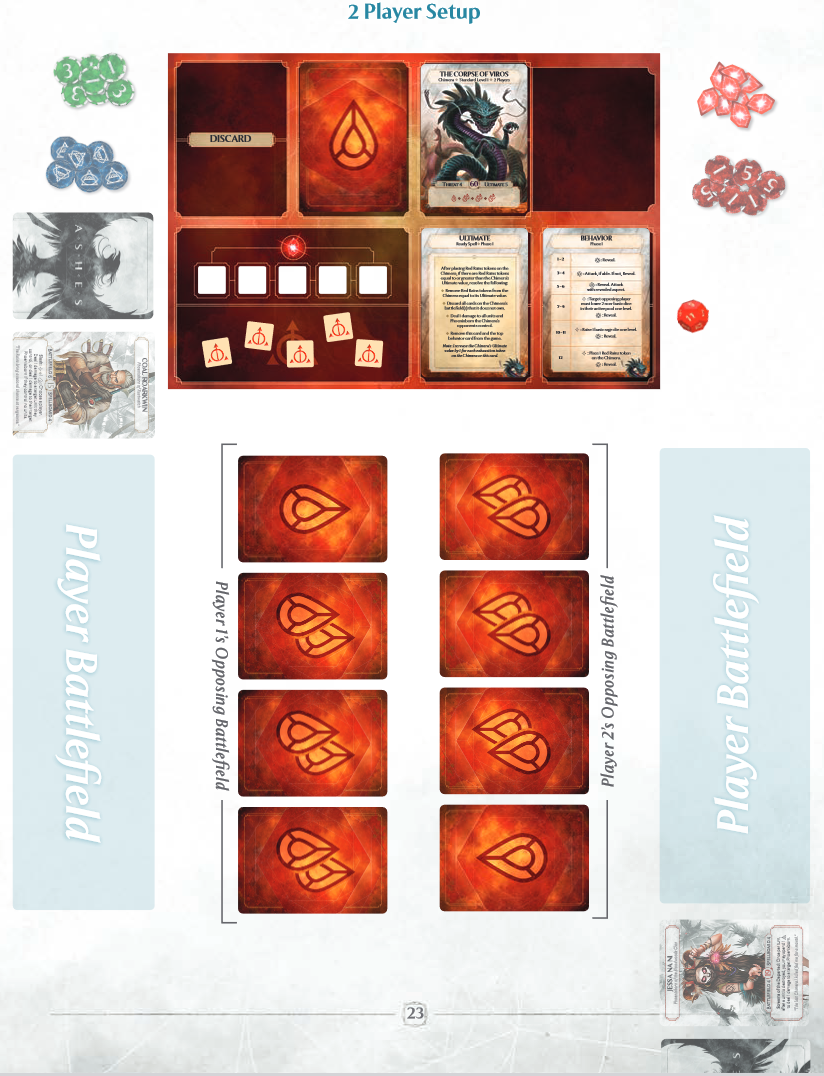](https://wiki.ashes.live/uploads/images/gallery/2023-09/scaled-1680-/image-1695322713510.png)
References
1. [Ashes Reborn Rulebook](https://wiki.ashes.live/books/rulebook/page/pdfs-pvp) v1.5, p5
2. [Red Rains Rulebook](https://media.plaidhatgames.com/filer_public/d0/f0/d0f0c379-df01-478f-82b4-f202f475a8f6/ph1225-5-chimera_rulebook-web.pdf) p6
# Game Flow
# Objective and Winning/Losing
### Object of the Game
#### Ashes: Reborn (PvP)
In Ashes, you are a Phoenixborn—a powerful magic wielder battling other Phoenixborn in a duel of wits and magical prowess. Cast spells and summon allies in an effort to destroy your opponents’ Phoenixborn and win the game.\[[1](https://wiki.ashes.live/books/rulebook/page/objective-and-winninglosing/#1 "Source")\]
#### Ashes: Red Rains (PvE)
In Ashes: Red Rains, you are a Phoenixborn–a powerful magic wielder battling a god-like monstrosity known as a Chimera. Cast spells and summon allies in an effort to destroy the Chimera and win the game.\[[3](https://wiki.ashes.live/books/rulebook/page/objective-and-winninglosing/#3)\]
### Winning and Losing the Game
#### Ashes: Reborn (PvP)
If a player’s Phoenixborn has a number of wound tokens on it equal to or greater than its life value, that Phoenixborn is destroyed. Their opponent has won the game!\[[2](https://wiki.ashes.live/books/rulebook/page/objective-and-winninglosing/#2 "Source")\]
#### Ashes: Red Rains (PvE)
If your Phoenixborn has a number of wound tokens on it equal to or greater than its life value, you lose the game. If the Chimera has a number of wound tokens on it equal to or greater than its life value, you win the game!\[[4](https://wiki.ashes.live/books/rulebook/page/objective-and-winninglosing/#4)\]
References
[1.](#1) Ashes Reborn Rulebook v1.5, p3
[2.](#2) Ashes Reborn Rulebook v1.5, p13
[3.](#3) Red Rains Rulebook v1.5, p2
[4.](#4) Red Rains Rulebook v1.5, p17
# Round Order
Ashes is played over a series of rounds. Each round is divided into three phases that must be resolved in order. Most of the game takes place during the player turns phase.
1\. PREPARE 2. PLAYER TURNS 3. RECOVERY
### Ashes Reborn (PvP)
Prepare Phase
During the prepare phase each player simultaneously resolves the following three steps in order:
1. **Roll Dice:** Roll all of the dice in your exhausted pool and place them to the left of your dice power reference cards. This is your active dice pool. On the first round of the game, the player who rolls the most basicsymbols chooses who should go first (the First Player), taking the first player token or giving it to their opponent. If there is a tie for most, all players must re-roll all of their dice until there is no tie.
2. **Discard Cards:** You may discard any number of cards from your hand.
3. **Draw Cards:** Draw cards until you have 5 cards in your hand.
- **Fatigue Damage:** Starting with the First Player, players alternate placing 1 wound token on their Phoenixborn until all players have placed wounds equal to the number of cards they should have drawn but could not.
Player Turns Phase
The player turns phase typically consists of many very short turns. Starting with the First Player, each player will take just one or two actions per turn. They will continue taking turns, back and forth, until both players consecutively pass on their turn.
On a player’s turn, they must take one main action and may choose to take one side action. These may be taken in either order. Once both players have taken Pass as their main action on consecutive turns, the player turns phase is over and the players move on to the recovery phase.
Recovery Phase
During the Recovery Phase, each player simultaneously resolves the following three steps in order:
1. **Recover:** Remove a number of wound tokens from each unit you have in play equal to that unit’s recover value.
2. **Remove Exhaustion:** Remove 1 exhaustion token from each card you have in play that has 1 or more exhaustion tokens on it. Rotate your Phoenixborn so that it is upright.
3. **Exhaust Dice:** Move any number of dice from your active pool to your exhausted pool.
##### End of Round
Some effects take place after the recovery phase “at the end of the round.” Each player (one at a time, starting with the First Player) resolves all effects they control that occur at the end of the round, in the order of their choice. After all such effects are resolved, the player with the first player token passes it to their opponent andthe next round begins.
Prepare Phase
During the prepare phase resolve the following three steps in order:
1. **Roll Dice:** Roll all of the dice in your exhausted pool and place them to the left of your dice power reference cards. This is your active dice pool.
2. **Discard Cards:** You may discard any number of cards from your hand.
3. **Draw Cards:** Draw cards until you have 5 cards in your hand.
- **Fatigue Damage:** Place 1 wound token on your Phoenixborn for each card you should have drawn but could not.
Player Turns Phase
The player turns phase typically consists of many very short turns alternating back and forth between your turn (the ‘player turn’) and the Chimera’s turn.
On your turn, you must take one main action and may choose to take one side action. You may take them in any order.
During the Chimera’s turn, it will also take a main action and possibly a side action, determined by game state and the behavior die.
Play will continue to alternate back and forth between you and the Chimera until you both Pass on consecutive turns. At that time the player turns phase will be over and play will move on to the recovery phase.
##### Battlefield Management
When you place units on any battlefield, they must be placed to the **right** of all other units on that battlefield and the **position of units cannot be changed** relative to each other. As units leave the battlefield, slide the remaining units to the left to fill in gaps. The Chimera will attack and resolve effects based on the positions of the units, so positioning and sequencing will be a crucial skill to defeating it!
- Players take a shared turn, with a main and side action each, in any order. Players are each allowed to play one reaction on each shared player turn and each Chimera turn.
- Card effects may **target** cards on ANY battlefield, spellboard, etc.
- **Passing:** The Red Rains halt for no one! If you take a Pass main action while there are 1 or more face down aspect cards on the opposing battlefield, the Chimera raises 1 basic rage die one level.
Recovery Phase
During the recovery phase, resolve the following steps in order:
1. **Recover:** Remove a number of wound tokens from each unit in play equal to that unit’s recover value. Aspects do not recover.
2. **Remove Exhaustion:** First, remove 1 Red Rains token from the Chimera for each exhaustion token on the Chimera and Ultimate cards. Then, remove 1 exhaustion token from each card in play that has 1 or more exhaustion tokens on it. Rotate your Phoenixborn so that it is upright.
3. **Exhaust Dice:** Move any number of dice from your active pool to your exhausted pool.
4. **Place Red Rains:** Place 1 Red Rains token on the Chimera for each aspect in play, resolving the Ultimate card if applicable.
5. **Replenish Aspects:** Add face down aspect cards to the Chimera’s battlefield (on the right) until its battlefield has a number of aspect cards equal to its threat value (face up or face down).
6. **Replenish Status Tokens:** For any aspects with status abilities, if they have fewer status tokens on them than there are pips on their status ability, refill their status tokens until they are equal to the number of pips.
##### End of Round
The first player (you or the Chimera) resolves all ‘end of round’ effects they control, then the other player does the same. The Chimera resolves from left to right, and you resolve in the order of your choice. Then, the first player token is passed.
**2-player:** When the first player token is passed to the Chimera, point it at the player who did not just have it. The Chimera will pass the first player token to that player at the end of the next round.
Example: Paying Costs
[](https://wiki.ashes.live/uploads/images/gallery/2023-05/PQMimage.png)To play Summon Iron Rhino to your spellboard, take your main action for the turn and exhaust 1 or die.
[](https://wiki.ashes.live/uploads/images/gallery/2023-05/MmMimage.png)To activate its effect, take your main action, place 1 exhaustion token on the card, and exhaust any six dice (any die can be used as ).
If you target a PHOENIXBORN do the following in order:
1. **Declare Attackers:** Choose ANY NUMBER of unexhausted units you control to be attackers.
2. **Opponent Declares Blockers:** Your opponent may block each attacker with up to one unexhausted unit they control.
3. **Resolve Battles:** Each attacking unit is now in battle with the corresponding blocking unit, if it was blocked. All unblocked attacking units are now in battle with the targeted Phoenixborn. One at a time, resolve each battle in an order of your choice.
- **If Blocked:** The attacker battles its blocker and the blocker counters.
- **If Unblocked:** The attacker battles the target Phoenixborn.
*Note:* Resolution order matters! If a blocker is destroyed before it battles, the attacker it was blocking becomes unblocked.
If you target a UNIT do the following in order:
1. **Declare Attackers:** Choose ONE unexhausted unit you control to be the attacker.
2. **Opponent Declares Guard:** Your opponent may guard with their Phoenixborn or with an unexhausted unit they control with the Unit Guard ability. *Note:* A Phoenixborn can only guard once per round, but may guard even if it is exhausted.
3. **Resolve Battle**
- **If Guarded:** The attacker and guard are now in battle, and, if the guard is a unit, the guard counters. If the guard is a Phoenixborn, it is rotated 90° to indicate it is unable to guard again this round.
- **If Unguarded:** The attacker and the target unit are now in battle. If it is unexhausted your opponent may counter with it.
Example of an Attack
[](https://wiki.ashes.live/uploads/images/gallery/2023-05/uzlimage.png)
If you target a CHIMERA do the following in order:
1. **Declare Attackers:** Choose ANY NUMBER of unexhausted units you control to be attackers.
2. **Declare Blockers:** If the Chimera has an unexhausted aspect with the **Defender** ability, it will block the leftmost attacker with that aspect. If there are multiple **Defender** aspects, it will assign one blocker to each attacker from left to right. Excess **Defender**s and **Defender**s on another battlefield do not block.
3. **Resolve Battles:** Any unblocked attackers are now in battle with the Chimera. Blocked attackers are in battle with the aspect that blocked them. One at a time, resolve each battle in the order of your choice.
- **If Blocked:** The attacker battles its blocker and the blocker counters.
- **If Unblocked:** The attacker battles the Chimera.
If you target a UNIT do the following in order:
1. **Declare Attackers:** Choose ONE unexhausted unit you control to be the attacker.
2. **Declare Guard:** The Chimera and its **Defender** aspects only guard aspects.
- If there are one or more unexhausted units with the **Defender** ability on the same battlefield as the targeted aspect, the leftmost one which can guard the attack is declared as a guard.
- If no Defender is declared as a guard, roll the behavior die. On a result of 9+, the Chimera guards, if able. Unlike Phoenixborn, the Chimera may guard any number of times per round.
- *Note:* The **Defender** ability states that the Chimera will not guard for **Defender** units being attacked. Since exhausted units have no ability text, the Chimera may guard for an exhausted aspect with the **Defender** ability, since it is currently not considered a Defender.
3. **Resolve Battle:**
- - **If Guarded:** The attacker battles the guard. If the guard is a unit, it counters.
- **If Unguarded:** The attacker battles the target unit. If it is unexhausted, it counters.
**Countering**
Aspects always counter if unexhausted, and they do not become exhausted as a result of countering.
**Blood Value**
When an aspect is destroyed or discarded from the battlefield, place a number of wound tokens on the Chimera equal to its blood value.
Example of an Attack
[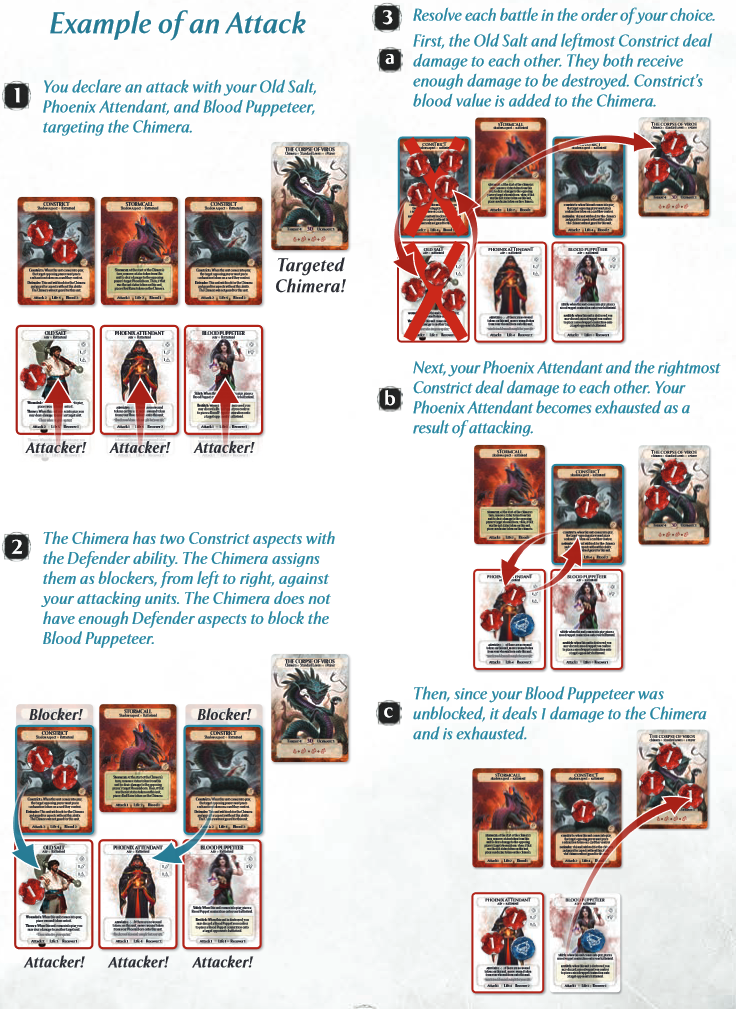](https://wiki.ashes.live/uploads/images/gallery/2023-09/9W0image.png)
Example of Complex Effect Resolution
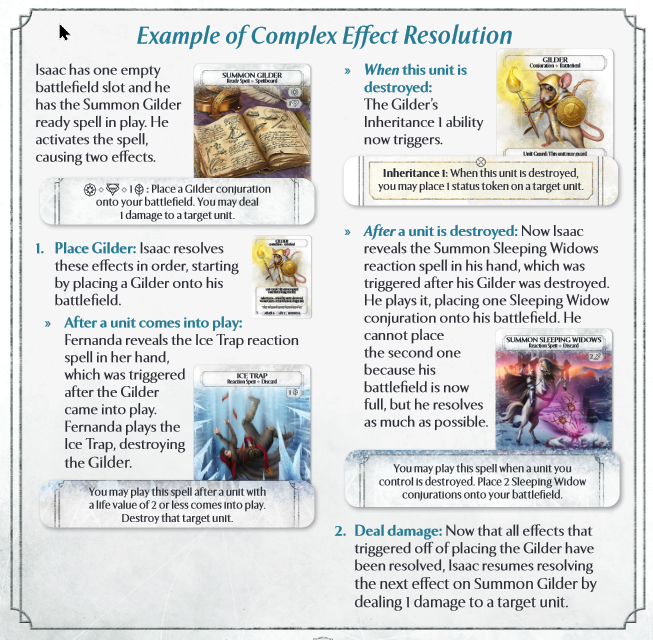
As of April 17th, 2025, there is no banned list. This is due to there being only one card on the list, and the errata on it removing the reasoning for the banning.[1]
History
Previously, as an experiment to curb the pervasive success of some deck types, an official banned list was created for Ashes on July 24, 2024.[2] Cards on the banned list could not be included in decks used in official organized play events, which is different from the Chained list. The only card banned was Molten Gold.
This list did not forbid any player from using the banned cards in Red Rains (PvE). Some events would also allow the banned card, usually due to deck building restrictions (ie, building using Red Rains Campaign rules).
References
# Card Errata
There have been 3 sets of errata so far, detailed below, oldest first. While Plaid Hat has decided that print runs will now include the fixed version of the cards instead of the older version, it is possible a product was printed before the errata and may not be up to date. Print on Demand decks will only have the current version of a card.
Previous changes
The initial 4 are available in a print-and-play file at plaidhatgames.com, and were included in The Frostwild Scourge expansion set.[1]
- [Salamander Monk Spirit](https://ashes.live/cards/salamander-monk-spirit/ "Salamander Monk Spirit on ashes.live") (The Song of Soaksend)
- Conjuration count 2
- 0 attack
- Replaced Transparent with \[INEX: Fleeting: Discard this card at the end of this round.\]
- [Brennen Blackcloud](https://ashes.live/cards/brennen-blackcloud/ "Brennen Blackcloud card on ashes.live") (Master Set - The Children of Blackcloud, and The Corpse of Viros)
- 18 life down to 16 life
- Revised Spirit Burn: Main, Exhaust, 1CC: Destroy an ally you control to deal 2 damage to a target Phoenixborn.
- [Three-Eyed Owl](https://ashes.live/cards/three-eyed-owl/ "Three-Eyed Owl card on ashes.live") (Master set)
- Conjuration count 2
- Gained Peer 1: When this unit comes into play, look at 1 random card in a target opponent’s hand.
- Revised Memory Drain 1: At the end of the prepare phase, choose a target opponent to discard 1 card of their choice from their hand.
- [Indiglow Creeper](https://ashes.live/cards/indiglow-creeper/ "Indiglow Creeper card on ashes.live") (The Boy Among Wolves)
- Conjuration count 1
The fifth was updated starting in The Spawn of Shadowreck.[2]
- [Rimea Careworn](https://ashes.live/cards/rimea-careworn "Rimea Careworn card on ashes.live") (The Ghost Guardian)
- 20 life down to 17 life
- Battlefield size up from 4 to 5
- Revised Visions: Side, Exhaust: Draw 2 cards. Then, look at 2 random cards in a target opponent's hand.
Latest changes
For Ashes Ascendency, 10 cards were updated, for clarity or power reasons.[3]
Clarity changes:
Power adjustments:
- [Molten Gold](https://ashes.live/cards/molten-gold "Molten Gold") (cost and targets changed)
- [Ice Trap](https://ashes.live/cards/ice-trap "Ice Trap") (cost changed)
- [Emperor Lion](https://ashes.live/cards/emperor-lion "Emperor Lion") (card overhauled)
- [Summon Fallen](https://ashes.live/cards/summon-fallen "Summon Fallen") (card overhauled)
References
# Chained List
Ashes Reborn has a set of cards that are not allowed to be included in a player's First Five, and cannot be played in the first round even if they come into a player's hand, for example, by card drawing, deck searching by cards like Open Memories, or a card that gets the chained card from the discard pile. In subsequent rounds, they may be played as normal. This list of cards is the "Chained List." Note that cards in the chained list may still be included in decks for events, unlike the cards in the [Banned List](https://wiki.ashes.live/books/rulebook/page/banned-list "Banned List").
This list is intended for Organized Play events, typically tournaments or leagues. That said, **it is common practice to use the chained list for all play**, even casual games online. Rare exceptions for certain formats, such as pre-constructed only, may exist. Always confirm with your opponent before playing.
#### The Chained List
As of April 5th, 2023, the list includes:
- [Explosive Growth](https://ashes.live/cards/explosive-growth/)
- [Golden Veil](https://ashes.live/cards/golden-veil "Golden Veil")
- [Hypnotize](https://ashes.live/cards/hypnotize "Hypnotize")
- [Meteor](https://ashes.live/cards/meteor/)
- [Psychic Vampire](https://ashes.live/cards/psychic-vampire/)
- [River Skald](https://ashes.live/cards/river-skald/)
- [Silver Paladin](https://ashes.live/cards/silver-paladin/ "Silver Paladin") (added October 29th, 2025)
- [Summon Shining Hydra](https://ashes.live/cards/summon-shining-hydra/)
- [Take to the Skies](https://ashes.live/cards/take-to-the-skies/ "Take to the Skies") (added October 29th, 2025)
#### Reasoning
"*There exist certain cards and card combinations that violate one or more of the core gameplay philosophies of Ashes when included in a player’s First Five."*
Some of the cards on the list are part of specific combos that are overly oppressive, and some are against the core principle of First Five.
PHG has included reasoning with each update of the chained list. You can read here:
1. [https://www.plaidhatgames.com/news/2021/06/02/ashes-june-update/](https://www.plaidhatgames.com/news/2021/06/02/ashes-june-update/)
2. [https://www.plaidhatgames.com/news/2022/05/16/ashcon2/](https://www.plaidhatgames.com/news/2022/05/16/ashcon2/)
3. [https://www.plaidhatgames.com/news/2022/10/03/new-organized-play-rules/](https://www.plaidhatgames.com/news/2022/10/03/new-organized-play-rules/)
4. [https://www.plaidhatgames.com/news/2023/04/05/ashes-card-changes-and-organized-play-update/](https://www.plaidhatgames.com/news/2023/04/05/ashes-card-changes-and-organized-play-update/)
5. [https://www.plaidhatgames.com/news/2024/01/25/ashes-organized-play-and-faq-update-v5/](https://www.plaidhatgames.com/news/2024/01/25/ashes-organized-play-and-faq-update-v5/)
6. [https://www.plaidhatgames.com/news/2025/10/29/dice-roller-app-op-update/](https://www.plaidhatgames.com/news/2025/10/29/dice-roller-app-op-update/)
#### Previous Cards
These cards were chained previously, but are no longer chained.
- [Exhortation](https://ashes.live/cards/exhortation/) (removed January 25th, 2024)
- [Massive Growth](https://ashes.live/cards/massive-growth/) (removed January 25th, 2024)
- [Summon Sleeping Widows](https://ashes.live/cards/summon-sleeping-widows/) (removed January 25th, 2024)
- [Three-Eyed Owl](https://ashes.live/cards/three-eyed-owl/) (the conjuration; removed April 5th, 2023)
The reasoning to remove each card is included in the update links above.
#### Technicalities
While it is possible to follow the current Organized Play rules and construct a legal deck that, due to the Chained list, cannot actually have a First Five (example [here](https://ashes.live/decks/38561/ "Unplayable deck")), doing so will result in a disqualification for the event. Source: Nick Conley, upon being asked about the linked deck.
# Rule Clarifications
### Abilities and Text
- Any text in a card’s text box that has the format of “X = ...” is not considered an ability. Only bold named text on a unit is considered an ability, such as Unit Guard.
- Abilities and other effect text still exist on cards that are exhausted; however that text is not active and cannot be used by that card. If a card would copy the printed abilities of a card that is exhausted, it may indeed copy those abilities.
- When paying an exhaust cost to activate a spell or ability, fully resolve the activated effects even though the exhausted card no longer has ability or effect text.
- Inexhaustible text that is granted to another card is also considered to be inexhaustible on that card.
### Battle
- If an attacker leaves battle before resolving its attack (either through becoming exhausted, leaving play, or another effect), any blocker or guard does not counter and a Phoenixborn declared as a guard would not use its guard for the round (do not rotate it 90°).
- If a blocker or guard leaves play before its battle is resolved, the attacker will resolve a battle with the original target of its attack.
- If an unguarded unit that is the target of an attack leaves play before that battle is resolved, the battle ends without dealing damage, but the attacker is still exhausted.
- Attackers are declared in a single step and blockers or guards are declared in a (separate) single step. After all attacker or blocker/guard choices have been made, effects that trigger when units are declared as an attacker/blocker/guard are resolved in the order of Simultaneous Effects (p. 17).
### Card Information
- If an effect has a player search their draw (or other) pile for a specified card, that player is not required to select a card, even if there is an eligible card remaining in that pile. If an effect has a player search their discard pile or any other area whose contents are public information, the cards must be revealed when selected.
- e.g. searching your discard pile for an ally and placing it into your hand.
- Face down cards that were public knowledge before being placed face down underneath another card in play may be examined by any player by request.
- e.g. cards placed underneath Mount conjurations or Canyon Shelter.
- If a card in play indicates the ability to place a conjuration into play, any player may request to see a copy of the named conjuration from the owner’s conjuration pile for reference.
### Dice
- Dice that are placed onto cards, such as with the charm and divine dice powers, are returned to their owner’s exhausted pool when the card they are on is discarded or otherwise removed from play. Dice that are placed onto cards are not considered to be in any player’s active or exhausted pool.
- When selecting a number of dice for an effect, choose as many as you can up to the indicated amount.
- You may take a Meditate side action with no dice in your active pool.
### Timing Outside of Player Turns
- Reaction spells or cards with a blue reaction box cannot be played outside of the player turns phase (e.g. Final Cry). Effects that can only trigger during a turn, or once per turn, also cannot be played outside of a player’s turn (e.g. Jessa Na Ni’s Screams of the Departed ability). Effects without these limits still may be triggered and resolved outside of the player turns phase (e.g. Chant of Revenge gaining a status token.)
- Effects that resolve outside of the player turns phase, such as end of round effects, resolve one player at a time, starting with the first player. In a 2p game of Red Rains, the players should resolve these effects one after another. These effects resolve one at a time, in the order of the player’s choice, until no more of these effects are left unresolved.
- If a new effect becomes active during the resolution of these effects, it is resolved, only if the player who controls that effect is still in the process of or has yet to resolve their effects.
### Miscellaneous
- If a unit would ever come into play onto a full battlefield, it is discarded instead.
- If a unit leaves play and then is placed back into play, it comes into play without any tokens on it, alteration spells attached to it, and it is not attacking, blocking or guarding. If it left and returned to play within the same turn without being placed in a discard pile, conjuration pile or hand, it is considered to be the same unit and is still subject to any other effects that had applied to it (see ‘Hope Everthorn’).
- You may not take main or side actions during another player’s turn, even if a card effect states you may take additional actions this turn.
- A card effect cannot place a conjuration into play that has been destroyed but not yet discarded unless it refers to that specific copy (e.g. via “this unit” or “that card”)
# Common Confusion
Plaid Hat Games maintains a FAQ for Ashes Reborn, which can be found here. Other sources of confusion are listed below.
Combat (Master set rules, page 10)
"Blocking" vs "Guarding"
Blocking is when one or more of your units intercept opposing unit(s) attacking your Phoenixborn.
Guarding is when either your Phoenixborn or a unit with the ability Unit Guard is put in front of an opposing unit attacking one of your units. Using your Phoenixborn to guard is usually referred to as "PB Guard" and can only be done once per round. When playing with physical cards, using the Phoenixborn Guard is represented by turning your PB sideways.
A unit that blocks or guards must counter. See the section "When can you choose to not counter with a unit?" below for when you can choose for a unit to not counter.
In PvE, unexhausted aspects with the Defender ability will block for the Chimera, or guard for other aspects that do not have the Defender ability. Like any other unit that blocks or guards, they will counter.
"In battle" and Tame
The definition of "Battle" on page 22 of the Master set rules provides more clarity on what a battle is: "An attacker is in battle with the unit or Phoenixborn it is dealing attack damage to." This means that even if there are 2 attackers and 2 blockers, each attacker and each blocker is only in battle with 1 other unit, and effects that are limited to "units in battle with this unit" only affect the battle the unit with that ability is in.
Example: A Hammer Knight and Iron Worker attack the opposing Phoenixborn. The player of the targeted Phoenixborn blocks the Hammer Knight with a Beast Tamer and the Iron Worker with a Mindfog Owl. The Beast Tamer's Tame 1 ability only affects the Hammer Knight, because neither the Iron Worker nor the Mindfog Owl are in battle with the Beast Tamer.
Units are "in battle" only after all guards or blockers have been declared for the attack main action. As such, Tame is not able to reduce a Shade Prowler's attack below the threshold needed to trigger Predator 3 before it triggers. This is basically only relevant when a Prowler attacks a Beast Tamer or an Essence Druid directly.
When do units exhaust as part of combat resolution?
For attackers, exhaustion tokens are placed after resolving their battle, if their wounds do not exceed their life.
For blockers and unit guards, exhaustion tokens are placed as a result of countering an attack. The Alert ability (e.g. Hammer Knight) prevents exhaustion being placed as a result of countering. A guarding Phoenixborn does not get an exhaustion token; they are turned sideways to indicate that they have guarded this round.
It is possible due to the resolution of effects and abilities that a defender does not exhaust if the attacking unit they are blocking is removed from combat before countering occurs. One example is Crystal Archer's Preemptive Shot 1 which can destroy a 1-life attacker when the Archer is declared as a blocker.
When can you choose to not counter with a unit?
If an unexhausted unit you control is directly attacked, and you do not or cannot guard it, you may choose to not have that unit counter (and thus, it won't exhaust). If the unit is already exhausted, it cannot choose to counter.
Targeting
When does a card or ability "target?"
Any card that says "target (something)" targets a card. Examples include "target unit," "target Phoenixborn," and, in the case of Whiplash (from the Corpse of Viros expansion), "target leftmost unit." Cards that have an effect that do not say "target," do not target (e.g. Nature's Wrath). Cards that target may be stopped by the appropriate card that cancels the effect (Golden Veil for units, Vanish for Phoenixborn or players).
Alterations target when they are attached, as per definition in the Master set rules, page 22.
The Concealed ability
The Concealed ability (present on Stormwind Sniper, Shadow Hound, and Lurk) is only active while the unit has no exhaustion tokens on it, and does not prevent abilities and effects that do not target. Cards like Mist Typhoon will still affect these units even when they have no exhaustion tokens. Chaos Gravity is trickier; it cannot place an exhaustion token onto these units as a part of the first effect, but it can move an exhaustion token to these units, because it does not target during that portion of the card ability.
Once the unit with Concealed is exhausted, it may be targeted as any other unit, as the exhaustion token renders their abilities blank.
Area of Effect (AOE) Selection and Resolution (Master set rules, page 17)
Some abilities and spells are card "area of effect" spells, because they do not target (e.g. Mist Typhoon). When these spells and abilities resolve, only the cards currently in play may be affected. In some cases, the affected cards may change during the resolution process, however, their initial selection does not get undone; they are still affected by the ability or spell. These spells and abilities affect units with Concealed (such as Stormwind Sniper or The Corpse of Viros's Lurk aspect), as Concealed only protects from targeted spells and abilities.
Example of resolution: Survival of the Fittest is played, and one player controls a Gilder and a Blood Archer, neither with any tokens. If the player who played Survival selects the Gilder first, and places the status token from the Gilder's Inheritance 1 ability onto the Blood Archer, the Blood Archer is still destroyed as a part of the resolution of Survival of the Fittest, as it did not have a token when it was selected as an affected unit.
Turn Structure
How/when fatigue works (Master set rules, page 6)
Fatigue damage occurs during the Prepare Phase (start of a round) when you have to draw until you have at least 5 cards in hand. For every card below 5 you are unable to draw, you take 1 damage on your Phoenixborn; this is referred to as fatigue damage. For example, if you have 3 cards in hand, and only 1 card left in your draw pile, you will take 1 fatigue damage that round. If you already have, or draw up to, at least 5 cards during the Prepare Phase, you will not take fatigue damage.
There are other cards that can punish having an empty draw pile but these are not fatigue damage, and the damage effect is stated on the card. For an example of this, see Abundance.
"End of the round" (Master set rules, page 13)
Abilities and effects that trigger "at the end of the round," like Cursed 1 on Blood Puppet, happen after the Recovery phase. These effects are outside of the Player Turns phase, which means Reaction cards and abilities cannot be played during this phase. However, abilities that trigger off of effects caused by any end of round abilities will still trigger.
Example: At the end of the round, a player using Jessa Na Ni has a Chant of Revenge and a Blood Archer with Fade Away attached. After the recovery phase, Fade Away triggers, destroying the Blood Archer and removing it from the game. Jessa cannot use Screams of the Departed because the ability states "Once per turn," and it is not during a turn. Chant of Revenge, however, gets a status token.
Reactions
You can only play reactions during the Player Turns phase; this means that the Prepare and Recovery phases do not allow for reactions or reaction abilities (blue text boxes, such as the one on Swift Messenger). As such, you are not allowed to use Summon Sleeping Widows or Final Cry as a reaction to a unit you control being destroyed at the end of the round due to an effect like Fade Away or the Fade ability.
There is a difference between Reaction spells and Reaction abilities, but only for cards that explicitly differentiate between them (Law of Sight). However, there is no difference between them in terms of Reactions per turn limit; if a player plays a Reaction ability in a turn, they are not allowed to play a Reaction spell later that same turn, or vice versa.
It is possible to play a Reaction to a Reaction. If a unit you control is destroyed by damage, and you respond with Summon Sleeping Widows, your opponent may then respond with Ice Trap to destroy one of the Sleeping Widows, provided they have not already played a Reaction this turn.
Specific cards
Void Pulse and Return to Soil
Older versions of these cards read "if that destroys the unit, after it is destroyed" clause that begins a sentence. Under the rules in the rulebook, this meant there were two contradictory timing windows in which the cards' second abilities would trigger: either after the unit is destroyed (a specific step in the destruction process), or, after the unit had been placed in the discard or conjuration piles (abilities are separated by periods). The prior ruling was that these effects took place in the destruction process, preventing the Return to Soil player from removing the destroyed unit (it hadn't yet hit the discard pile), or allowing the Void Pulse player to attempt to prevent Reactions based on destruction triggers (like Summon Sleeping Widows or Final Cry).
These cards' language has been cleared up to remove the ambiguity: the second and subsequent abilities happen after the unit has been placed in either the discard pile or the conjuration pile.
Rowan Umberend
Rowan's Exhume ability allows you to replay an ally, which will trigger both "when this unit comes into play" and "when this unit is destroyed" abilities, such as both the abilities on Knowledge Seeker.
Miscellaneous
Printed vs Resolved Card Values and "X"
For "printed" values, X is X and no other value. It is not zero, nor is it the value of X at the time of resolution. Example: Rile The Meek will never get to deal a damage from a Wishing Wing, even if it has zero status tokens on it.
For non-printed values, X is its current numeric value as given by its definition (unless looking at magic play cost, which the rules explicitly calls out as zero). Example: Amplify may be played on a Wishing Wing, if and only if it has zero status tokens on it.
Using a Die Power from the Exhausted Pool
When a card allows you to choose a dice from your exhausted pool and resolve its dice power, that die does not have to be on its power side; you only have to match the die type.
Examples:
Summon Mind Fog Owl is a little different than the above; it specifically calls out the dice used to pay the cost, so while resolving the power does not care about the side the die is on, the focus ability itself does.
# Ashes: Red Rains FAQ
#### Rules Clarifications
- In a 2 player game of Red Rains, the Chimera takes a turn against each opponent, starting with a turn against the first player (or the player the first player token is pointing to when the Chimera is the first player).
- Red Rains tokens are placed one at a time, potentially triggering an ultimate to resolve, followed by continued placement of the remaining Red Rains tokens that would be placed.
- While players are allowed to make decisions regarding choices the Chimera must make, this choice should be ignored when the Chimera is resolving simultaneous damage as a result of an aspect attacking. When an attacking aspect deals damage to a defending unit that counters, always resolve the attack damage first.
- The Chimera will continue reshuffling its discard pile to create a new draw pile any time it is depleted, even after it reaches Fatigue.
- The Chimera does not reshuffle its draw pile when it is required to create a hand of 5 cards for the purposes of effects that affect the Chimera’s hand if the draw pile has less than 5 cards. In this case, use as many cards as there are remaining to create the hand.
- Facedown aspects are not considered to be in play until they are revealed.
#### Play Variants
**Grim Fates:** When making choices for the Chimera, instead of the players choosing any options for the Chimera, they may instead force themselves to choose the worst possible outcome for themselves, evaluated to the best of their ability. Players may apply this rule globally, or may choose to apply it to specific cards to better satisfy their play preferences. Some examples of cards to apply the Grim Fates variant to:
- E.g. Abundance allows the players to normally choose how many cards the Chimera will draw. Under the Grim Fates variant, the Chimera would always attempt to draw 2 cards, as to not take direct damage before reaching Fatigue.
- E.g. Generosity gives the Chimera a choice between receiving 2 beneficial effects. Under the Grim Fates variant, the Chimera should choose the effect most beneficial to it, or take the effect that the player wanted to resolve the most afterwards.
#### FAQs
##### General
Q: Does the Chimera have to spend dice from its active pool when it activates a side action behavior?
A: No. The side action behaviors are just considered to be dice powers for the purpose of cards that check for the source of an effect. For example, Golden Veil can cancel the effects of a spell, ability or dice power, therefore it can cancel a side action behavior that targets a unit you control.
##### Light Bringer
Q: If I use Light Bringer’s Infatuate ability to force the Chimera to take an Attack main action on its next turn, does it still roll the behavior and rage dice if there are facedown aspects?
A: No. The Chimera Rulebook (pg. 10) lists the actions the Chimera will take on its turn. Light Bringer’s Infatuate ability makes the Chimera choose to Attack with its leftmost unit that can attack, instead of rolling dice to determine its actions for the turn.
##### Coal Roarkwin
Q: In a 2-player game, if my opposing battlefield has no faceup aspects on it, but my partner’s opposing battlefield does, can I use Slash to deal 1 damage to the Chimera?
A: Since the Chimera controls units, even though they are opposing your partner, you cannot use Slash to deal 1 damage to the Chimera directly. You still may use Slash to target units on the battlefield opposing your partner though.
##### Whiplash
Q: How does Whiplash’s targeting work?
A: Whiplash will destroy the leftmost unit among units the opposing player controls with 1 or more wound tokens on it. If there are none, it will deal 1 damage to the opposing player’s leftmost unit.
# Individual Card FAQs
##### Accelerate
Q: If I use Copycat on Accelerate, can I take side actions on my opponent’s turn?
A: No. Per the Rules Clarifications, players can only take main or side actions on their turn.
##### Ash Spirit
Q: If I am the only player with no cards in my draw pile at the end of the round, do I have to take 1 damage from my own Ash Spirit’s Smolder 1 ability?
A: Yes, Ash Spirits can be a double-edged sword. Be careful around fiery sheep!
##### Blink
Q: What happens to the unit I use Blink on if, by the end of the turn, the battlefield it is returning to play onto is full?
A: Per the Rules Clarifications, it is discarded.
##### Blood Archer
Q: If placing a wound token on my Blood Archer from the Blood Shot 1 ability would cause my Blood Archer to be destroyed, do I still get to deal 1 damage to a target unit?
A: Yes, fully resolve the ability, even though the Blood Archer is not in play when that part of the ability resolves.
##### Bone Crow
Q: When attacking with Bone Crow, if it triggers its Feast 1 ability, but the target of the attack changes to an unwounded card when my opponent blocks or guards, do I keep the attack bonus from Feast 1?
A: Yes.
##### Canyon Shelter
Q: If I have multiple copies of Canyon Shelter in play, can I activate one copy of Canyon Shelter to place a unit underneath a different copy of Canyon Shelter since focusing causes some copies to be underneath others?
A: No, each copy of Canyon Shelter independently has units underneath them.
##### Chained Creations
Q: If I use Chained Creations to destroy a conjuration, can I place an exhaustion token on Resummon?
A: No. Resummon does not specifically say what kind of conjuration it puts into play, so Chained Creations cannot exhaust it.
##### Channel Magic
Q: Can I use this card in player vs player Ashes games?
A: Yes, up to 3 copies of Channel Magic can be included in a player’s deck, like any other card.
##### Chant of Transfusion
Q: What happens if my opponent uses Golden Veil to cancel the movement of a wound token onto a target unit they control?
A: Both units are targeted before resolving the effect of Chant of Transfusion, so if a Golden Veil is played, the wound token will not be moved at all.
##### Choke
Q: If I play Choke, can I still deal 1 damage to a target Phoenixborn even if they were exhausted before I played Choke?
A: No. Choke requires you to exhaust a Phoenixborn to deal the damage.
##### Copycat
Q: If I use Copycat to resolve a copy of Meteor, how much damage can I do?
A: Just the base 1 damage to all units. The copy of Meteor was played without paying its play cost, so no were spent to play it, even if one was spent to play Copycat.
Q: When I use Copycat on Odette’s Enter the Fray ability, which Phoenixborn is dealt damage in return?
A: Yours. When using Copycat, the default assumption should be that you become the player casting the spell and your Phoenixborn is using any Phoenixborn ability being copied.
Q: Can I play Copycat after my opponent uses Copycat to copy the same spell or ability?
A: Yes. Copycat may be played immediately after the originally copied spell or ability is resolved.
Q: If I use Copycat in response to an effect that can place a conjuration onto my battlefield, like Summon Shining Hydra, do I get to do so?
A: You may only place that conjuration if you happen to have a copy of it in your conjuration pile. This can only be done if that conjuration was added to your conjuration pile during deck construction as a result of including the card that can place it in your deck build. So in this example, you may only place a Shining Hydra via Copycat if you included your own copy of Summon Shining Hydra in your deck build, thus having a copy of Shining Hydra to place. If you did not include Summon Shining Hydra in your deck build, you do not have a Shining Hydra available to place vis Copycat.
##### Dark Presence
Q: If I use Dark Presence to give Beast Tamer the Terrifying 1 ability in addition to Tame 1, and it attacks, can it be blocked by a Turtle Guard with an attack value of 2?
A: Yes. Abilities like Terrifying check the relevant stat value only during the declare blockers/guard step, and then are otherwise irrelevant. If the Turtle Guard has an attack value above that of the Terrifying ability when it can be declared as a blocker, it may be declared.
##### Dimona Odinstar
Q: Is this the first ‘Mount’ unit that references exhausted units?
A: Yes, Dimona instead Promotes allies that have proved their worth in battle!
##### Disengage
Q: Does my attacking unit become exhausted after playing Disengage?
A: No (see Battle above).
##### Double Down
Q: When a conjuration is destroyed and I play Double Down as a result, can I place that same copy of that conjuration into play?
A: No, conjurations must come from the conjuration pile, and at the time of resolving Double Down, the destroyed conjuration is not yet in the conjuration pile. You must place 2 copies (or as many as you can) of that conjuration from your conjuration pile.
##### Emperor Lion
Q: If I play Law of Sight while using the Emperor Lion’s Decree ability, will I draw cards that I saw on the top of my draw pile while searching for a Law?
A: Due to the possibility of manipulating the order of your draw pile, you should shuffle your draw pile immediately after searching your draw pile for a Law and revealing it, despite the fact that shuffling is listed as the last part of Decree’s effect. This will ensure the cards drawn from Law of Sight are random.
##### Empyrean Mount
Q: Does Battlemaster do anything when targeting a unit for an attack?
A: No. If you want your Empyrean Mount to battle a specific unit, instead attack the Phoenixborn and use Battlemaster to choose that unit as a blocker. If you attacked the unit directly, your opponent could still declare a guard.
##### Era’s End
Q: What effects resolve when playing Era’s End in the case that one of those effects would exhaust a card with an effect pending resolution, like Crypt Guardian?
A: All unexhausted cards in play with an end of round effect at the time of playing Era’s End will be recognized as in queue to resolve. However, if one of those cards becomes exhausted, say by Crypt Guardian’s Shackle 1 ability, during the process of resolving Era’s End, the exhausted card will lose its ability text and will not resolve from Era’s End when it’s time comes to resolve.
Q: Who chooses how to resolve an opponent’s effect triggered by Era’s End?
A: The controller of the card resolving.
##### Fade Away
Q: Is the ‘remove from game’ text on Fade Away considered a second effect, or a modifier of the first effect?
A: It is a modifier of the first effect, indicating that after the ally is destroyed, instead of discarding it, remove it from the game.
##### Fade Away and Undying Heart
Q: If Fade Away destroys an ally I control that has Undying Heart attached, do I return the ally to my hand or remove it from the game?
A: Return it to your hand. The effect of Undying Heart returns the ally to your hand before that ally would be discarded. Fade Away attempts to remove the ally from the game instead of discarding it. Since the ally is returned to your hand (and not discarded), Fade Away does not remove the ally from play.
##### Fear and Undying Heart
Q: If I use Fear to destroy a unit with Undying Heart attached to it, will the amount of wound tokens I remove from Jessa be modified by Undying Heart’s +1 recover value?
A: Yes, Fear uses the recover value the unit had at the time it was destroyed.
##### Fox Spirit
Q: If I activate Pounce 2 by attacking an exhausted unit with my Fox Spirit and the target of the attack changes from my opponent’s guarding, what happens?
A: Once Pounce 2 activates, the +2 attack persists for the remainder of the turn regardless of how the opponent chooses to respond to the attack.
##### Ghostly Mounts
Q: If I summon Spectral Charger Mount and my opponent destroys it with Ice Trap, what happens to the ally that was removed from play to summon my Mount?
A: Consider placing the Mount and the ally underneath the Mount to be a single step; thus Dismount would trigger and place the ally into your hand.
##### Golden Veil
Q: When canceling one of several effects on a card with Golden Veil, such as the exhaustion token placement on Law of Fear, what happens to the remaining effects on Law of Fear that were not currently resolving?
A: Only currently resolving effects are canceled. Passive modifiers like Law of Fear’s -1 attack effect, Bound, and Fleeting, are still in effect after the exhaustion token placement is canceled by Golden Veil.
##### Hope Everthorn
Q: Can I use a reaction spell like Summon Sleeping Widows at the end of my turn when a unit I control is destroyed as a result of Duplicate?
A: Yes, and this reaction is considered to be used on your turn that is currently ending with regards to the “Limit 1 reaction per turn” rule.
Q: I used Duplicate on my Vampire Bat Swarm and that copy was destroyed before the end of this turn. If I put it back into play with the Swarm ability, will it be destroyed as a result of Duplicate at the end of the turn?
A: Yes, when using the Swarm ability to place that Vampire Bat Swarm back into play, it is still under the effects of Hope’s Duplicate ability.
##### Hunter’s Mark
Q: If I use Enchanted Violinist’s Song of Sorrow ability to destroy a unit with Hunter’s Mark attached to it, do I trigger the discard effect from Song of Sorrow?
A: Yes. Hunter’s Mark modifies the amount of wound tokens placed by Song of Sorrow, but the source of the damage is still the Enchanted Violinist, allowing you to discard 1 card from the top of that opponent’s draw pile.
##### Imperial Ninja
Q: What happens if I only can discard 1 card from my deck against an Imperial Ninja’s attack?
A: If you choose to discard the card from your deck, the Interrogate ability still causes you to discard the looked at card, since you discarded fewer than 2 cards.
##### Iron Worker
Q: If I am at or above my maximum hand limit of 5, can I still draw cards with Iron Worker’s Overtime ability?
A: Yes. You may draw 0-2 additional cards during the draw step, regardless of how many cards you have in your hand.
##### Meteor
Q: If I spent to play this, am I required to deal the damage?
A: Yes. You may not spend a and ignore the damage boosting effect of Meteor.
##### Mind Probe
Q: When I use Mind Probe, does my opponent get to see the order I return the cards back to their draw pile?
A: No. You are allowed to pick up the remaining cards, determine their order secretly, and return them to your opponent’s draw pile.
##### Nightsong Cricket
Q: If I play Crescendo to destroy my Nightsong Cricket, can that copy of Crescendo be added into my hand by its Renewed Harmony ability?
A: No, Crescendo is not fully resolved at that time, and is not yet in the discard pile.
##### Odette Diamondcrest
Q: How much damage does Odette take when using Enter the Fray against a Dread Wraith?
A: If you use Enter the Fray against an undamaged Dread Wraith, Odette is dealt 3 damage, because the Dread Wraith’s attack is increased to 3 by the time Odette is dealt damage by her ability.
Q: How much damage does Odette take when using Enter the Fray and it destroys the target unit?
A: If the targeted unit is no longer in play when Odette is dealt damage from her ability, use the attack value of the unit at the time of its destruction (e.g. a Dread Wraith that has a Frozen Crown and 7 wound tokens on it when destroyed would deal 11 damage to Odette!)
##### Piercing Light
Q: Do multiple copies of Piercing Light stack the Overkill ability?
A: Yes (Stacking Abilities, Glossary).
##### Radiant Leviathan
Q: If my Radiant Leviathan is destroyed during the end of round steps, will the Prism Tetras it summons be discarded by Scatter?
A: It depends on when the Leviathan is destroyed. End of round effects are resolved player by player, starting with the First Player. If you are the First Player and resolve all your end of round effects first, then your opponent destroys your Leviathan (say, with Red Raindrop), the Tetras you summon will not be discarded from Scatter, as you have already passed the window in which you resolve your end of round abilities for that round. If your Leviathan is destroyed by Fade Away while resolving your end of round effects, the newly summoned Tetras will have to resolve Scatter during your end of round resolutions.
##### Rayward Recruit and Blessing of Lightning
Q: Must I choose a divine die on its power side when resolving Blessing of Lightning or the Armed ability?
A: No, any divine die, regardless of what face it is on, and including the die spent to play them, can be used to resolve these effects.
Q: Can I use the dice spent to play these cards when resolving their effects?
A: Yes, costs are paid before resolving these effects, so you may use the spent divine die.
##### Redirect
Q: What happens if I use Redirect to make a unit I control with Armored 1 receive that damage?
A: The unit receives full damage. Since the damage was dealt to your Phoenixborn, but received by the unit, Armored 1 does not trigger (Damage Resolution, p. 16).
Q: If I use Redirect to make my Blood Shaman receive enough damage for it to be destroyed, can I use Blood Shaman’s Blood Ritual 1 ability?
A: It depends on the source of the damage dealt to your Phoenixborn that triggered Redirect. The source of the damage does not change when Redirect is used. If the source of damage was your own spell, ability, or dice power, then yes. Otherwise, Blood Ritual 1 does not trigger.
##### Return to Soil
Q: If I use Return to Soil to destroy a Raptor Herder, can I remove it from the game with the rest of Return to Soil’s effect?
A: No. The destroyed Raptor Herder is not in the discard pile at the time of resolving that part of Return to Soil.
##### Rile the Meek
Q: What happens when I use Golden Veil to stop damage from Rile the Meek?
A: That damage, and all subsequent instances of damage from Rile the Meek, are canceled.
##### Rowan Umberend
Q: If an ally I control is destroyed by Fade Away, can I still Conscript it with Rowan, or will it be removed from the game?
A: You may use Conscript without Fade Away removing the ally from the game (See Fade Away above). Since Conscript prevents the ally from being discarded, Fade Away cannot remove the ally from the game instead of discarding it.
##### Safeguard
Q: If I play Safeguard and pass as a main action, ending the round, does Safeguard carry over into the next round?
A: Yes. You will be protected by Safeguard until the start of your next turn, regardless of if the round ends between those turns.
##### Seafoam Snapper
Q: If my Seafoam Snapper with 1 status token is dealt 2 damage while I have Fate Reflection in hand, how much damage will I do if I play Fate Reflection?
A: Fate Reflection will always deal the amount of damage dealt (2 in this case), whether or not another effect would also prevent damage. Additionally, even if Fate Reflection is used to prevent the damage, Tough is not an optional effect, so you will spend the status token for Tough even when using Fate Reflection.
##### Shield Mage
Q: What does Shield Mage’s ability do?
A: Since your units cannot be targeted by attacks an opponent controls, the Shield Mage’s Defensive Aura ability essentially means your opponent must target your Phoenixborn for an attack instead of your units. This allows you to assign blockers more freely than if they were able to target your units for attacks.
##### Stasis
Q: Can Stasis be used as a reaction against Squall Stallion’s Lightning Speed ability?
A: No. Per its effect text, Stasis is considered a reaction spell for the purposes of Lightning Speed when played using the blue reaction text box.
##### Strange Copy
Q: If I use Strange Copy to turn my unit into a Vampire Bat Swarm, when it is destroyed, how does the Swarm ability work?
A: You may spend 1 or 1 to return that unit to play as a Vampire Bat Swarm (without tokens or alteration spells). It is not considered to be the original unit until Strange Copy wears off at the end of the turn.
Q: If I use Strange Copy to turn my unit into a Shield Mage while my opponent is attacking a unit I control, what happens?
A: The opponent continues attacking that unit. Shield Mage’s Defensive Aura ability will not be active in time to affect the declaration of this attack.
Q: If I use Strange Copy to copy an exhausted unit, do I copy its exhaustible abilities even if they aren’t active on that card?
A: Yes. Per the Rules Clarifications above, the Strange Copy unit will have all of the source unit’s printed abilities, even if the source unit is exhausted.
Q: If I transform my Psychic Vampire into a different unit with Strange Copy and it survives battle damage, but then is destroyed by a reduction in life value when it transforms back into Psychic Vampire, can I trigger Lobotomize?
A: No. Psychic Vampire is not dying from an opponent’s effect at that point, but rather from the game state change of Strange Copy’s effect wearing off.
Q: Does an ally being copied into a conjuration (or vice versa) change its card type?
A: No, the original unit is still considered its own card type for the purposes of cards like Chant of Revenge triggering when an ally you control is destroyed.
##### String Mage
Q: How does cancelling work when moving a token with Exchange Link 1?
A: Golden Veil can cancel the entirety of the Exchange Link 1 ability since it is played when a unit is targeted by the effect, but before resolving the effect (Target, p. 26).
##### Tidal Shift
Q: What happens if Tidal Shift gets canceled, such as by Golden Veil?
A: The entire card effect is canceled since the unit is targeted before resolving any of Tidal Shift’s effect.
##### Transmute Magic
Q: Am I required to target all players with the last effect?
A: Yes. Per the effect text, you target all players at once, then a cancel effect (such as Vanish) can be declared and resolved. Otherwise, you then change dice in the order of your choice.
##### Tristan Darkwater
Q: What numerals does Tristan’s Magnify ability affect?
A: Abilities with a numeral in their ability title are affected. Increase that numeral by 1, and all instances of that same numeral in that ability’s text. Do not increase numbers written out (e.g. “one”).
##### Tsunami Shot
Q: What happens when I use Golden Veil to stop Tsunami Shot?
A: That damage, and all subsequent instances of damage from Tsunami Shot are canceled.
##### Undying Heart and Fade Away
See Fade Away.
##### Vampire Bat Swarm
Q: If a Vampire Bat Swarm is attacking or blocking, is destroyed, and triggers Swarm to re-enter play, is it still attacking or blocking?
A: No, the new Vampire Bat Swarm is not considered to be attacking or blocking (see Rules Clarifications above).
##### Victoria Glassfire
Q: When I use the Surprise! ability and I have fewer dice in my active pool than the number of dice re-rolled for my opponent, how many of my dice do I roll?
A: Roll as many dice as you can up to the amount re-rolled for your opponent.
##### Void Pulse
Q: How does the sequencing of effects work with Void Pulse? Can I use the dice spindown effect to prevent my opponent from having the dice to play a reaction spell in response to their unit’s being destroyed, like Final Cry?
A: Void Pulse’s secondary effect of drawing cards and changing dice is triggered “after \[the unit\] is destroyed.” As the active player, you must draw cards/change dice before your opponent has the opportunity to trigger any effects off of their unit’s destruction, such as playing Final Cry.
# References
Direct reference material from Plaid Hat Games
# PDFs - PvE
[Chimera Rulebook](https://media.plaidhatgames.com/filer_public/d0/f0/d0f0c379-df01-478f-82b4-f202f475a8f6/ph1225-5-chimera_rulebook-web.pdf)
[Red Rains Rulebook](https://media.plaidhatgames.com/filer_public/a4/69/a46924ae-f0b2-4431-9b4b-5e8a97d3d5ea/ph1225-5-rulebook-web.pdf "Full Rulebook")
# PDFs - PvP
[Ashes Reborn Rulebook](https://media.plaidhatgames.com/filer_public/23/15/23151a90-9295-4a82-87d0-970df6dc5f04/ashes_reborn_rulebook_final.pdf "Master Set (Full) Rulebook")
[Ashes Reborn FAQ v.4](https://media.plaidhatgames.com/filer_public/be/5d/be5dadbd-c740-47ad-9df3-e3dc8777be94/ashes_reborn-faq-version4-proof1.pdf "FAQ for Ashes Reborn")
[Ashes OP Rules V4](https://media.plaidhatgames.com/filer_public/18/3b/183b924f-834d-4a38-9763-be914e2c43a9/op_rules-version4-proof4.pdf "Organized Play with Chained List")
[Ashes Reborn Primer](https://media.plaidhatgames.com/filer_public/b9/24/b924e0fb-a97e-4c89-ac51-ba0d6b200370/changed_cards_list.pdf "Primer for Ashes Reborn")
[Dice Reference Cards (a.k.a. "Dice Power Reference Cards")](https://media.plaidhatgames.com/filer_public/1d/da/1ddaf856-ec54-4eb5-9bdb-075f32a1de4d/dice_references.png "Ashes Dice Powers")
[Printable Errata Cards](https://media.plaidhatgames.com/filer_public/12/f5/12f53e6e-b970-40d1-8f17-13ae8ba2a0ca/ph1226-5-errata_cards-front_and_back-printable.pdf "Ashes Reborn Card Errata since OP v4")
# Extra Rules That Need Placing
#### Phoenixborn Uniques
This expansion introduces new Phoenixborn unique cards for previously existing Phoenixborn. When constructing a deck, players may mix and match their Phoenixborn’s unique cards, but cannot exceed three total. In addition, no more than one Phoenixborn unique card may be included in a player’s First Five.
### Red Rains Nuances
#### DECK FROM THIS SET
This set comes with 4 Phoenixborn and 12 Phoenixborn unique cards (3 cards for each Phoenixborn).
To build a deck using only cards from this set follow these simple steps:
1\. Choose a Phoenixborn and collect its 3 unique cards. Return all other Phoenixborn and their unique cards to the box.
2\. Locate the 6 Channel Magic cards and return them to the box too.
3\. Take all remaining cards with white backs (including your 3 Phoenixborn unique cards)and shuffle them together to form your draw pile.
4\. Gather all of the cards with black backs together to form your conjuration pile.
5\. Gather 10 ceremonial dice to form your dice pool. 


